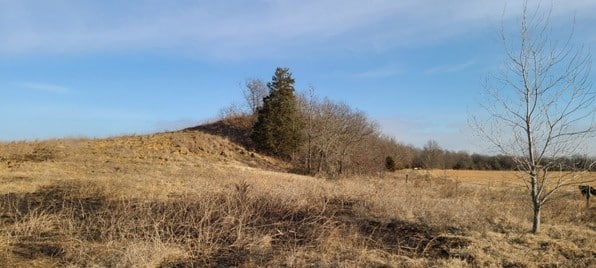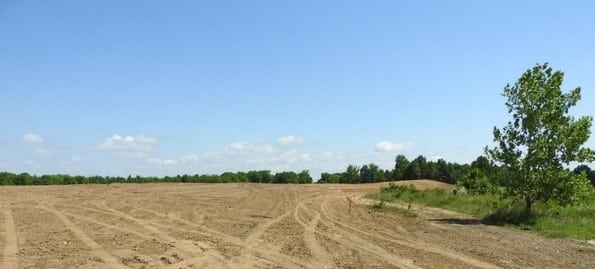Recently completed Reclamation project is excellent example of Abandoned Mine Land work in Oklahoma
Some believe you can’t go back in time.
However, that’s exactly what the Abandoned Mine Land Reclamation Program does. In this case, they’ve returned nearly 24 acres to productive use that were surface mined for coal over 45 years ago.

Construction on the Owen-Cherokee West Abandoned Mine Land Reclamation project in the Muskogee County Conservation District reached completion on July 20 and two days later the Final Inspection of the Project in eastern Oklahoma was held. The concluding phases of the project included: the final grading stage of earth work, the installation of rip rap, rock check dams, and fencing. A dangerous highwall and a hazardous waterbody have been removed from the site. This project is in a highly visible location at an intersection with heavily traveled county roads. The property has been dramatically improved, and the landscape conforms to the natural environment with the elimination of significant health and safety hazards. Approximately 23.5 acres of land have been reshaped and reclaimed.
Robert Toole, Oklahoma Conservation Commission Abandoned Mine Land Reclamation Program Director, said this project is a good example of AML work in various ways.
From a technical standpoint, the Oklahoma AML Program secured the right-of-entry for the private property needed for the project. They then designed the plans, coordinated the environmental clearances, contracted the second American Burying Beetle survey, contracted the construction, inspected construction, prepared the vegetative plan, coordinated the vegetative services and inspected the vegetative treatment application.
From a partnership standpoint, the Surface Mining Control and Reclamation Act of 1977 (SMCRA) established a cooperative federalism approach to abandoned coal mine reclamation.
Toole said, “This project is a prime example of how well that approach works to address abandoned mine land reclamation on any land in Oklahoma.”
The project was a partnership effort involving the Cherokee Nation, the Office of Surface Mining Reclamation and Enforcement, the Oklahoma Conservation Commission, the Muskogee County Conservation District and private landowners.
The work area involved Cherokee Nation abandoned mine land that needed maintenance for which the Office of Surface Mining Reclamation and Enforcement (OSMRE) was providing technical assistance.
“The maintenance treatment necessary to alleviate the problems required the involvement of adjacent private property abandoned mine land for which the Oklahoma AML Program had authority to reclaim,” Toole said. “Through a Cooperative Agreement, the OSMRE coordinated the involvement of the Cherokee Nation land and the Oklahoma AML Program coordinated the inclusion of the private property land. Funding was jointly provided by OSMRE for the Cherokee Nation land acreage and by the Oklahoma AML Program for the private land acreage.”
Toole added, “In collaboration with OSMRE, the Oklahoma AML Program designed the Cherokee Nation land maintenance treatment in coordination with the abandoned mine land reclamation of the private land to create a contiguous work area that addressed the needs of all interests to the maximum extent possible.”

The Oklahoma AML Program then performed all project management including contracting, construction inspection and vegetative treatment oversight. The Muskogee County Conservation District served as the vegetative contractor to secure the best vegetative services available. This cooperative project involved the federal government, state government, local government, tribal government and private landowners.
“It doesn’t get much more partnership than that and yet it worked very efficiently and effectively with the Oklahoma AML Program coordinating communications, input and project management,” Toole said.
Those who participated in the final inspection at the site included: Butch Garner, Muskogee County Conservation District Chair; Pat Gwin, Cherokee Nation; LaChelle Harris, OSMRE Tulsa FO; Lee Owens, landowner; Valerie Rogers, OCC-AML Engineer; Tracy Reeder, OCC-AML Construction Supervisor; Trampas Tripp, OCC-AML Program Assistant/Project Inspector, and Toole, OCC-AML Program Director.
Discussions between AML and OSMRE about this project began in 2017, and the Cooperative Agreement was executed the following year (2018). The notice to begin construction was given on January 5, 2021 and was completed in July.
This reclamation project was part private landowner and part Cherokee Nation land.

Such projects afford many opportunities for producers, sometimes it is business related, sometimes it is more quality of life. Owens, the private landowner, said a neighbor cuts the hay on her land and this will provide more land for that use. Plus, the reclamation opens the door for use by her grandchildren as they make memories.
“This was a wooded area before, but now this gives us easier access to my other acreage for the grandkids to go fishing,” she said, followed by a big smile.
The AML mission
The mission of Oklahoma’s Abandoned Mine Land Reclamation Program is to protect lives, repair scarred land and improve the environment. Twenty-six (26) known deaths have occurred in the state on abandoned coal mines. Oklahoma has over $120 million in reclamation that needs to be addressed and receives only $3 million per year. The authority provided by the Surface Mining Control and Reclamation Act of 1977 as amended to collect fees to fund AML reclamation expires in September 2021. If the Act is not reauthorized, Oklahoma will have millions of dollars of hazardous abandoned coal mine sites left unreclaimed.
AML achievements to date includes: 187 completed projects; 5,520.7 acres reclaimed; 320,048 linear feet of dangerous highwall reclaimed; 258 hazardous water bodies reclaimed; 223 subsidence sites reclaimed; 22 hazardous structures removed; 397 mine openings closed; 16 miles of clean streams restored.
Looking back
Coal mining started in Oklahoma in 1872, taking place primarily in a 16-county area on the eastern side of the state. Early production came almost entirely from underground mines, but with the development of larger power equipment, surface mining became the preferred approach and continues to be the primary mining method used in the state. Over 32,000 acres of land have been used for surface mining and another 40,000 acres have been used for underground mining, resulting in many abandoned mining sites that threaten the environment as well as Oklahomans’ health and safety.
For years, conservation district directors in eastern Oklahoma voiced their concerns about these unclaimed mined areas and spoke to local lawmakers about legislation to address the issue. This advocacy led to the passage of the Open Cut Land Reclamation Act in 1968, which required leveling only the tops of spoil ridges to a width of 10 feet, a requirement that many deemed inadequate. In 1971 these reclamation guidelines were strengthened to require “a rolling topography traversable by machines or equipment commonly used with the land after reclamation.” Still dissatisfied by this requirement, conservation district directors and other environmental advocates turned to Congress for assistance in passing more robust mine reclamation legislation.
On August 3, 1977, President Jimmy Carter signed Public Law 95-87, known as the Surface Mining Control and Reclamation Act of 1977. This legislation created a national system for controlling the surface effects of active coal mining and established a trust fund dedicated to reclaiming hazardous orphan coal mine land. The trust is funded by fees on active coal mining that are set to end in 2021.
Within months of Public Law 95-87 passing, Governor David Boren designated the Oklahoma Conservation Commission as the state agency responsible for reclaiming abandoned coal mine land in Oklahoma. On May 19, 1981, Governor George Nigh signed Senate Bill 217 implementing the Abandoned Mine Land (AML) Program in Oklahoma, which was subsequently approved by Cecil Andrus, the Secretary of the U.S. Department of the Interior at the time. Oklahoma is one of the few states where conservation districts are integrally involved with AML reclamation efforts. These efforts are 100 percent federally funded from fees on active coal mine production.
Take for example, projects of the past…
There have been many other successes through the years. Here are a couple of those:
The Lindsay AML Project is located near Claremore, Oklahoma, close to the Oologah Reservoir in Rogers County. A 50-foot final-cut highwall and pit paralleled the road to the reservoir. With considerable residential development in the area, there was a strong potential for an accident. The pit was backfilled using the on-site spoil piles, eliminating 2,700 linear feet of highwall. A total of 37 acres was reclaimed at a cost of $227,114. The project was completed August 12, 1992.
The Bill Tipple Civil Penalty Project is adjacent to Highway 10 near Welch, Oklahoma, in Craig County. The site was an abandoned coal-processing facility with many dilapidated structures and equipment creating safety hazards. The presence of approximately 15,000 cubic yards of acid-forming surface coal refuse posed a major threat to the underlying groundwater aquifer as well as a public health hazard. The site was eligible for funding under the federally administered civil penalty program. Hazardous structures and equipment were either salvaged or buried. The coal refuse was buried with a minimum 2-foot clay cover. A total of 55 acres was reclaimed at a cost of $201,285.70. It was completed August 26, 1993.
Of the Owen-Cherokee West Reclamation project, Toole said, “This project is a model for performing abandoned coal mine land reclamation on any land in Oklahoma through the Oklahoma Conservation Commission Abandoned Mine Land Reclamation Program.”
